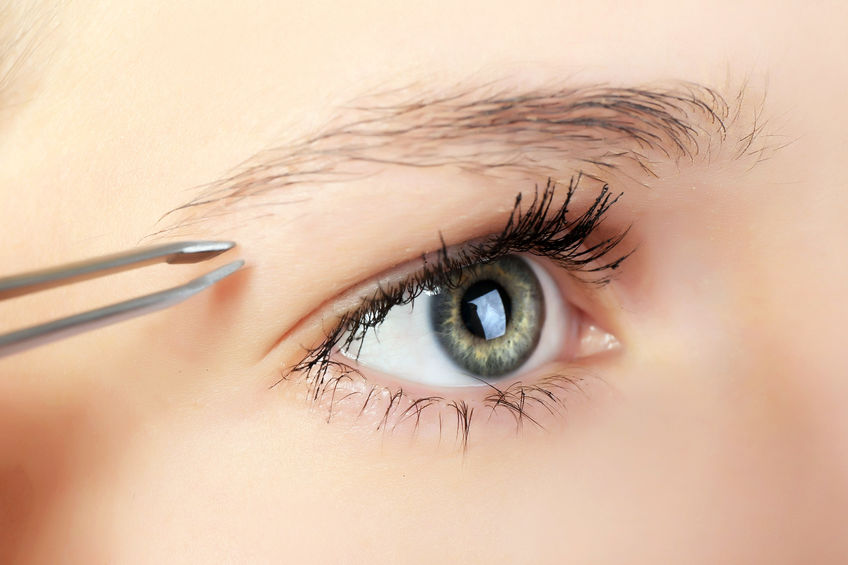Eyebrows serve an important function. Primarily, they are there to protect the eyes, diverting moisture such as sweat and other impurities – like dirt – away from the eyes and down the sides of the face. This is true for the unkempt eyebrow that hasn’t undergone eyebrow shaping, in its original state. Today, eyebrows also serve as an important aesthetic feature – bringing more emphasis to facial expressions with certain grooming and shaping techniques.

Eyebrow shaping and other procedures and conditions that affect eyebrows
The loss of eyebrows or lowered eyebrow density can cause some alarm to the person suffering the loss. There are a number of reasons for eyebrows to become scant and lose their density. Some of these are precursors to other conditions while many of the modern-day grooming techniques used by beauticians and DIY enthusiasts can also lead to dermatological problems with the eyebrows;
- Aging and hormones – Hair follicles often thin with age, which leaves the hair growing out thinner. In some cases, the hair follicles stop producing hair altogether resulting in patchy growth and bald areas. This applies to the hair on your head and eyebrows. In the case of menopause, abrupt hormonal changes can also trigger hair loss. The same can occur following pregnancy. In both cases, it usually takes around 6 months for the symptoms to normalise.
- Ocular Rosacea and styes – This condition is an inflammatory condition in which there is a flushed appearance and sometimes pustules on the eyelids. Other common symptoms include burning and red eyes which can result in too much rubbing due to irritation. This inflammation can lead to hair loss in the eyelashes and eyebrows.
- Low thyroid function – The thyroid is a butterfly-shaped gland that sits near the throat. It is responsible for secreting TSH, a hormone which is responsible for maintaining cellular respiration (the rate at which your body converts nutrients into energy – also known as the metabolism). When there is too much or too little thyroid hormone, a number of symptoms arise; such as low energy, coldness, weight gain, hair loss, and heart palpitations.
- Nutritional Deficiencies – The food we consume fuels the body’s processes. For that reason, a diet that contains a balance of vitamins and minerals is essential. Low iron, low zinc, and a sudden reduction in protein levels can lead to hair loss. Anaemia and eating disorders like anorexia nervosa can lead to poor hair growth as the lack of nutrients can send the hair follicles into a state of hibernation.
- Various forms of dermatitis
– Seborrheic dermatitis is characterised by an over-production of oil on the skin leading to dandruff. It is believed to be caused by a fungal infection. This condition can affect the eyebrows and eyelashes.
-Contact dermatitis is often the result of cosmetics triggering an allergic reaction on the eyelids or around the eyelashes. The irritation may become apparent when the skin feels burny or itchy. It is possible for the irritation to lead to hair loss as the follicles stop producing hair.
- Telogen effluvium – This condition arises and results in hair loss when the hair follicles experience an interruption in their normal functions – for example – a change in hormones, dietary changes, or other sudden events. The hair follicles respond by reducing the production of new hair.
- Alopecia Areata – This condition refers to hair loss which can affect any area of the body in individuals who are otherwise healthy. Alopecia areata can affect the face, including the eyes and eyebrows. You can protect your eyes and eyebrows and prevent this condition by:
-Avoiding false eyelashes
-Avoiding stick-on eyebrows
-By wearing glasses to protect your eyes
- Frontal Fibrosing Alopecia – This form of hair loss is scarring, meaning it is permanent. It can be prevented from spreading further but it requires treatment. This condition can also affect the eyebrows and eyelashes.
- Leprosy – Mycobacterium is the bacteria that causes the sores and skin lesions which are the primary symptom of leprosy. Damage to autonomic nerves can prevent hair growth and even affect the ability of the person to sweat. Leprosy can be treated, leading to fewer such symptoms.
- Eyebrow shaping and other cosmetic procedures – Excessive eyebrow grooming, waxing, tweezing and shaping techniques can lead to progressive thinning of the brow. This is often irreversible and stands to emphasise the importance of leaving your cosmetic procedures in the hands of reputable beauticians.
Eyebrow shaping and the latest grooming trends
There are many wonderful eyebrow treatments and trends that are safe. However, we recommend avoiding tattooing. Many of the most popular eyebrow and eyelash grooming techniques are safe, provided they are performed in reputable facilities by experienced practitioners. These include;
- Eyebrow shaping
- Microblading
- Eyebrow and eyelash tinting
While these treatments are safe when they are done correctly, they can still interfere with the diagnosis of medical conditions – for example – when there is thyroid disease and the patient has undergone microblading, it can be difficult to detect.

When you embark on a care routine that is safe, ensure you avoid cleansers that are astringent (drawing moisture) and opt for hypoallergenic products that offer UV protection. Ensure that the products you use are not going to cause an allergic reaction, triggering inflammation. Oil-based water-resistant products also frequently contribute to dryness and eczema around the eyes, all of which contribute to hair loss.
If you are experiencing thinning of the eyebrows or loss of lashes, contact Dr Khoza – it is easier to stop further damage and repair the loss earlier before it’s too late. We are always ready to help!


